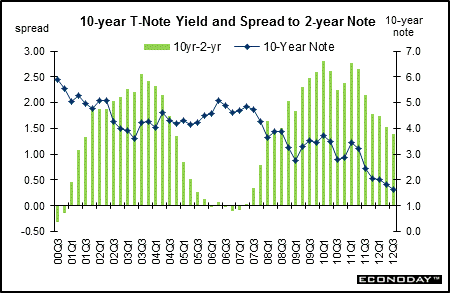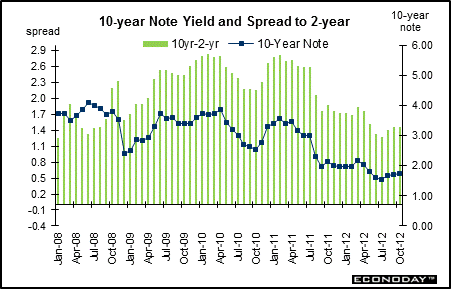 |

The spread between long and short interest rates tends to widen near economic downturns and narrows during recovery/expansion. The spread narrowed in 1998 and 1999. In 2000, the yield curve inverted. That is, 10-year note yields were lower than 2-year note yields. Often this behavior signals an economic slowdown due to expected tightening by the Fed. But the spread fell over the late 2003 through 2006 period and it appears to have been related to a rise in near-term credit demand and a rise in near-term inflation expectations while longer-term inflation expectations held steady. From the end of 2007 and through 2009, flight to quality and the past recession sharply depressed the two-year rate while the ten-year bond did not decline as much due to a boost in inflation expectations at the time. With the sluggish recovery and low core inflation, soft rates continued in 2010, 2011, and 2012.

The spread between 2-year and 10-year note yields flipped back to positive territory in June 2007 and had been steadily rising into early 2008 as yields on the 2-year note dropped faster than those for the 10-year note. Briefly during mid-2008 when credit markets appeared to be improving, both rates rose but with the 2-year gaining at a somewhat faster pace of the two. Also, some traders temporarily decided that the Fed would be raising rates in coming months and this expectation boosted the 2-year note while rising inflation concerns also firmed yields on both bonds. Then record high oil prices had much to do with these views. Credit markets seized again in late 2008, causing massive flight to safety and a drop in Treasury yields. In the second half of 2009, improved economic data suggested the start of recovery but a sluggish one. Also, concern over looming supply of Treasuries to fund the ballooning federal deficit bumped longer rates up. But the Fed announced in 2009 that the fed funds rate would remain low for an “extended period” and in August 2011 the Fed stated this would likely continue until at least mid-2013. In January 2012, the Fed stated that exceptionally low rates are likely through late 2014. At the September 2012 meeting, guidance language was changed to mid-2015 and this stance was affirmed in October 2012. This stance continues to weigh on the 2-year T-note. This note also has been a favorite when flight to safety has been sought—such as with the sovereign debt crisis for several European countries. The spread firmed 1 basis point to 147 percentage points in October. This reflected the average yield on the 10-year note increasing 3 basis points to 1.75 percent and the 2-year note rising 2 basis points to 0.28 percent.

 |


Production & Sales •
Inflation •
Federal Reserve Policy •
Interest Rates
|
 |